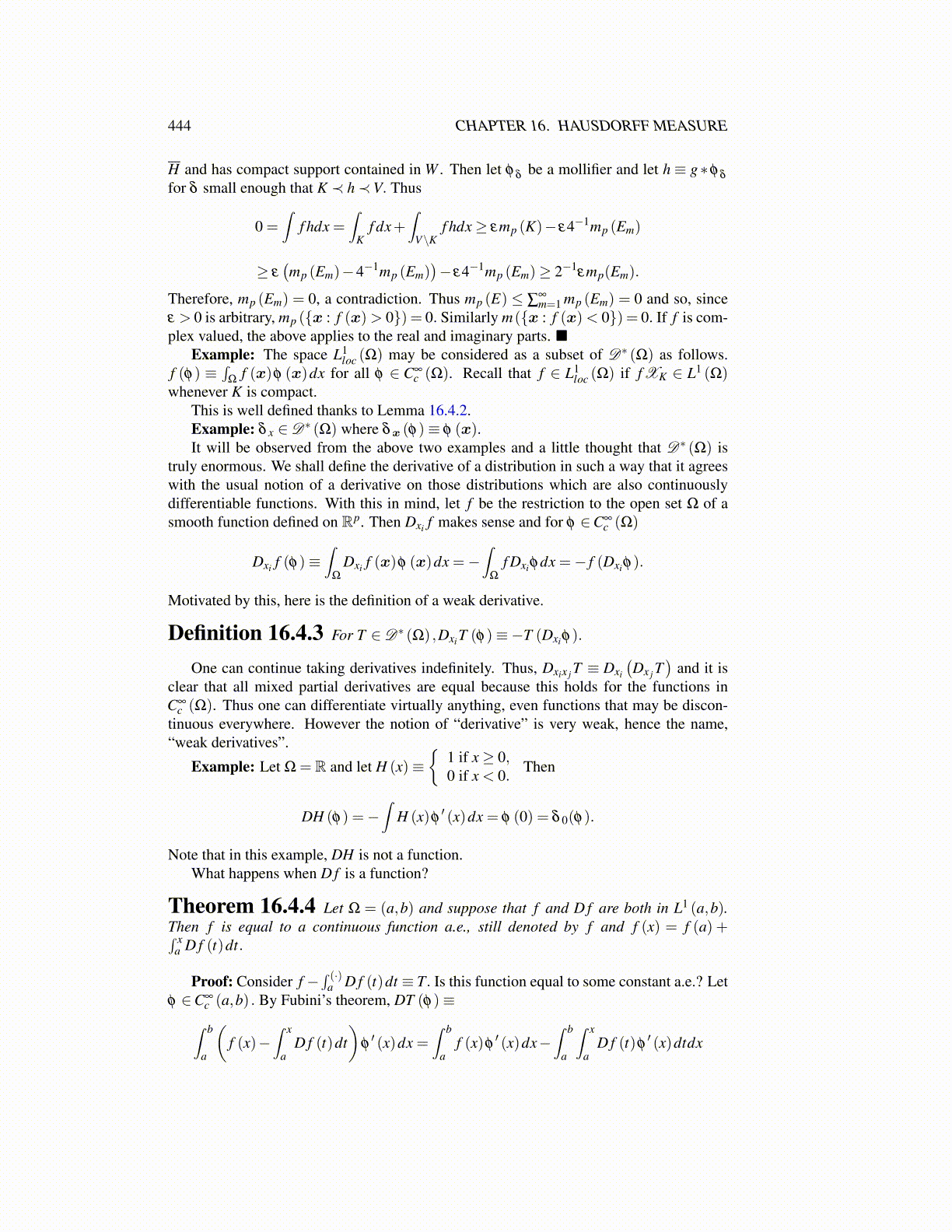
444 CHAPTER 16. HAUSDORFF MEASURE
H and has compact support contained in W . Then let φ δ be a mollifier and let h ≡ g ∗φ δ
for δ small enough that K ≺ h≺V. Thus
0 =∫
f hdx =∫
Kf dx+
∫V\K
f hdx≥ εmp (K)− ε4−1mp (Em)
≥ ε(mp (Em)−4−1mp (Em)
)− ε4−1mp (Em)≥ 2−1
εmp(Em).
Therefore, mp (Em) = 0, a contradiction. Thus mp (E) ≤ ∑∞m=1 mp (Em) = 0 and so, since
ε > 0 is arbitrary, mp ({x : f (x)> 0}) = 0. Similarly m({x : f (x)< 0}) = 0. If f is com-plex valued, the above applies to the real and imaginary parts. ■
Example: The space L1loc (Ω) may be considered as a subset of D∗ (Ω) as follows.
f (φ) ≡∫
Ωf (x)φ (x)dx for all φ ∈ C∞
c (Ω). Recall that f ∈ L1loc (Ω) if f XK ∈ L1 (Ω)
whenever K is compact.This is well defined thanks to Lemma 16.4.2.Example: δ x ∈D∗ (Ω) where δx (φ)≡ φ (x).It will be observed from the above two examples and a little thought that D∗ (Ω) is
truly enormous. We shall define the derivative of a distribution in such a way that it agreeswith the usual notion of a derivative on those distributions which are also continuouslydifferentiable functions. With this in mind, let f be the restriction to the open set Ω of asmooth function defined on Rp. Then Dxi f makes sense and for φ ∈C∞
c (Ω)
Dxi f (φ)≡∫
Ω
Dxi f (x)φ (x)dx =−∫
Ω
f Dxiφdx =− f (Dxiφ).
Motivated by this, here is the definition of a weak derivative.
Definition 16.4.3 For T ∈D∗ (Ω) ,DxiT (φ)≡−T (Dxiφ).
One can continue taking derivatives indefinitely. Thus, Dxix j T ≡ Dxi
(Dx j T
)and it is
clear that all mixed partial derivatives are equal because this holds for the functions inC∞
c (Ω). Thus one can differentiate virtually anything, even functions that may be discon-tinuous everywhere. However the notion of “derivative” is very weak, hence the name,“weak derivatives”.
Example: Let Ω = R and let H (x)≡{
1 if x≥ 0,0 if x < 0. Then
DH (φ) =−∫
H (x)φ′ (x)dx = φ (0) = δ 0(φ).
Note that in this example, DH is not a function.What happens when D f is a function?
Theorem 16.4.4 Let Ω = (a,b) and suppose that f and D f are both in L1 (a,b).Then f is equal to a continuous function a.e., still denoted by f and f (x) = f (a) +∫ x
a D f (t)dt.
Proof: Consider f −∫ (·)
a D f (t)dt ≡ T. Is this function equal to some constant a.e.? Letφ ∈C∞
c (a,b) . By Fubini’s theorem, DT (φ)≡∫ b
a
(f (x)−
∫ x
aD f (t)dt
)φ′ (x)dx =
∫ b
af (x)φ
′ (x)dx−∫ b
a
∫ x
aD f (t)φ
′ (x)dtdx